Advancements in artificial intelligence have transformed content creation from a tedious chore into a smooth and efficient process.
With AI handling many manual tasks, marketers need to understand AI-generated marketing content and its benefits to choose the right tools and strategies for their goals.
In this blog post, I’ll dive deeper into the top AI-generated marketing content types, using data from HubSpot’s State of AI survey, which includes insights from over 1,062 U.S. marketers.
I’ll also share AI-generated content examples and tips so you can see its potential in action. By leveraging these insights, you can enhance your content strategy and gain a competitive edge.
Table of Contents
Top Content Types for Generative AI
- Social Media Posts
- Product Descriptions
- Emails
- Images
- Blog Posts
- Landing Pages
- Ebooks
- Whitepapers
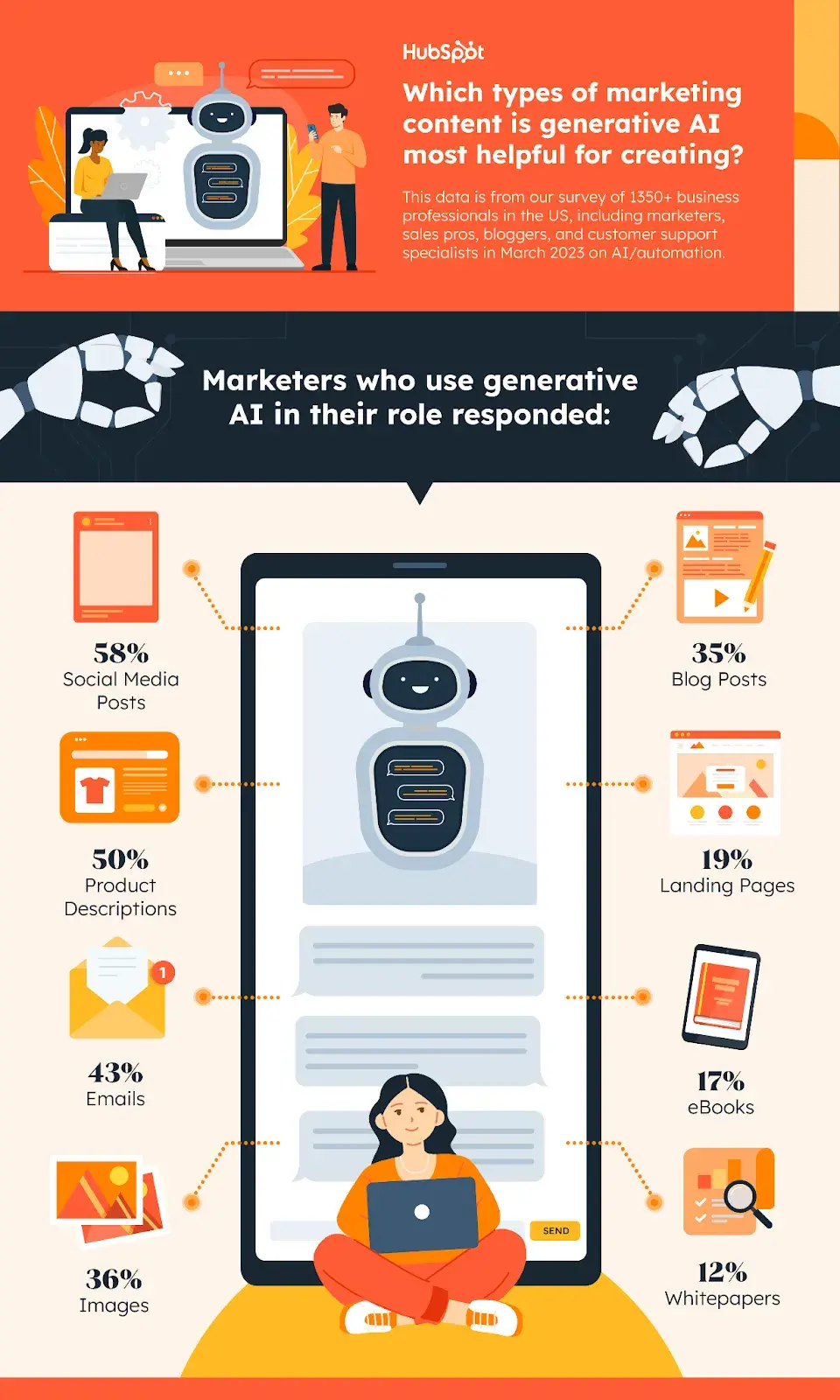
1. Emails and Newsletters (47{326198e71d5f7582f354f6f6ee7a089ba2f57e2fa39b69186a2948f78a2d5740})
46{326198e71d5f7582f354f6f6ee7a089ba2f57e2fa39b69186a2948f78a2d5740} of marketers regularly use AI to produce marketing content, including emails.
Catching your customers’ attention through email subject lines is a challenge in itself, and it is even trickier to get them to click open. With the help of AI, marketers can improve their strategy through:
- Timing optimization: AI tools can suggest the best time of the day and day of the week to send a particular email based on when the recipient is most likely to engage with the email. This can improve open rates, click-through rates (CTR), and conversions.
- Subject line generation: AI can generate effective and catchy subject lines by analyzing past email campaigns, and the subject line’s performance. If these tools can create grabby subjects, it could increase open rates.
- A/B testing: AI can be used to conduct A/B testing, where two different versions of the same email are sent to a random portion of the audience, and performance is measured. Based on the results of this testing, the best-performing email variant can then be sent to the rest of the audience, to maximize desired metrics.
Here’s an AI-generated email example I created using HubSpot’s AI Email Writer:
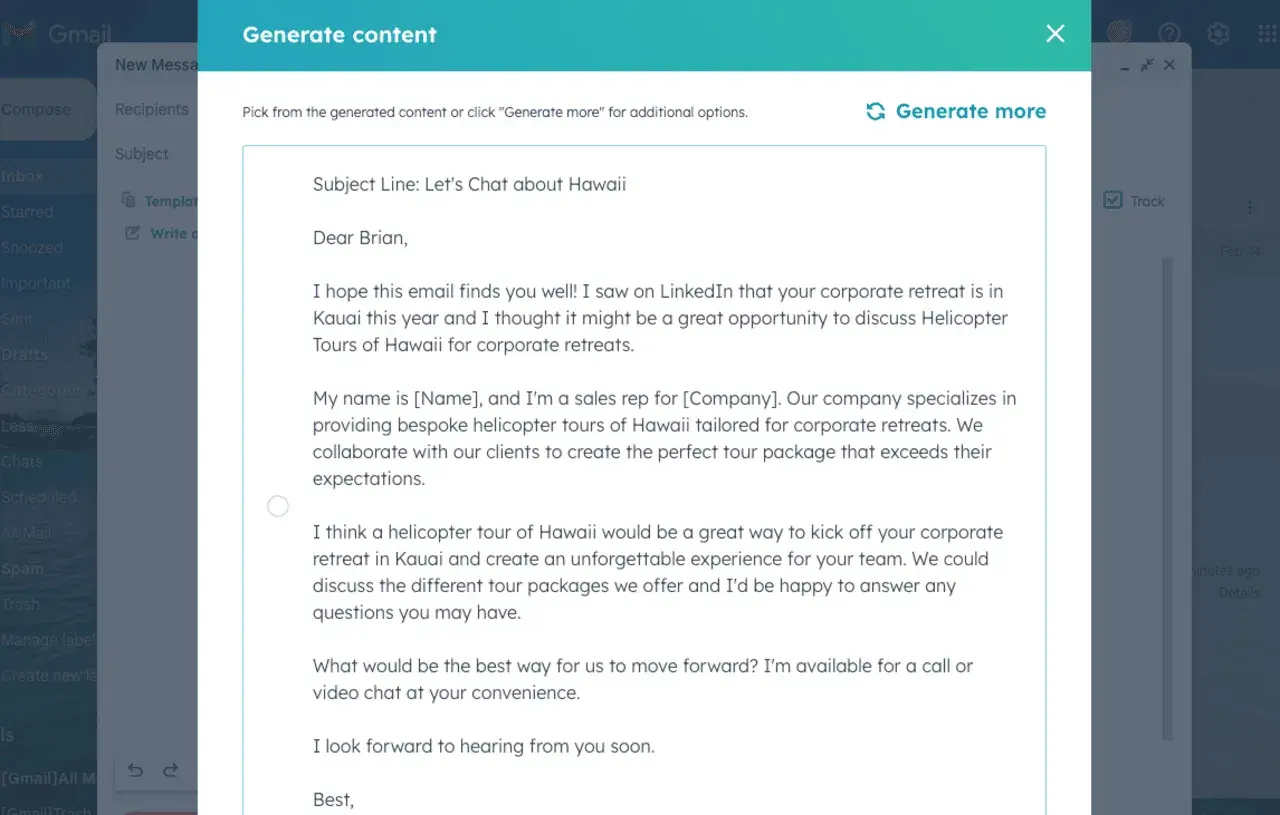
2. Social Media Posts (46{326198e71d5f7582f354f6f6ee7a089ba2f57e2fa39b69186a2948f78a2d5740} for Text-Based, 46{326198e71d5f7582f354f6f6ee7a089ba2f57e2fa39b69186a2948f78a2d5740} for Video/Audio)
The most popular use for marketers leveraging AI for content is for social media posts, and with good reason.
Social media marketers have to make content their audience will enjoy, and using a content assistant makes managing a social media calendar much easier. Marketers can use AI for social media posts:
- Content Creation: AI tools can help generate content ideas, suggest topics, and even write headlines for social media posts. In fact, 43{326198e71d5f7582f354f6f6ee7a089ba2f57e2fa39b69186a2948f78a2d5740} of surveyed marketers use AI for content creation. Check this AI-generated Facebook post:
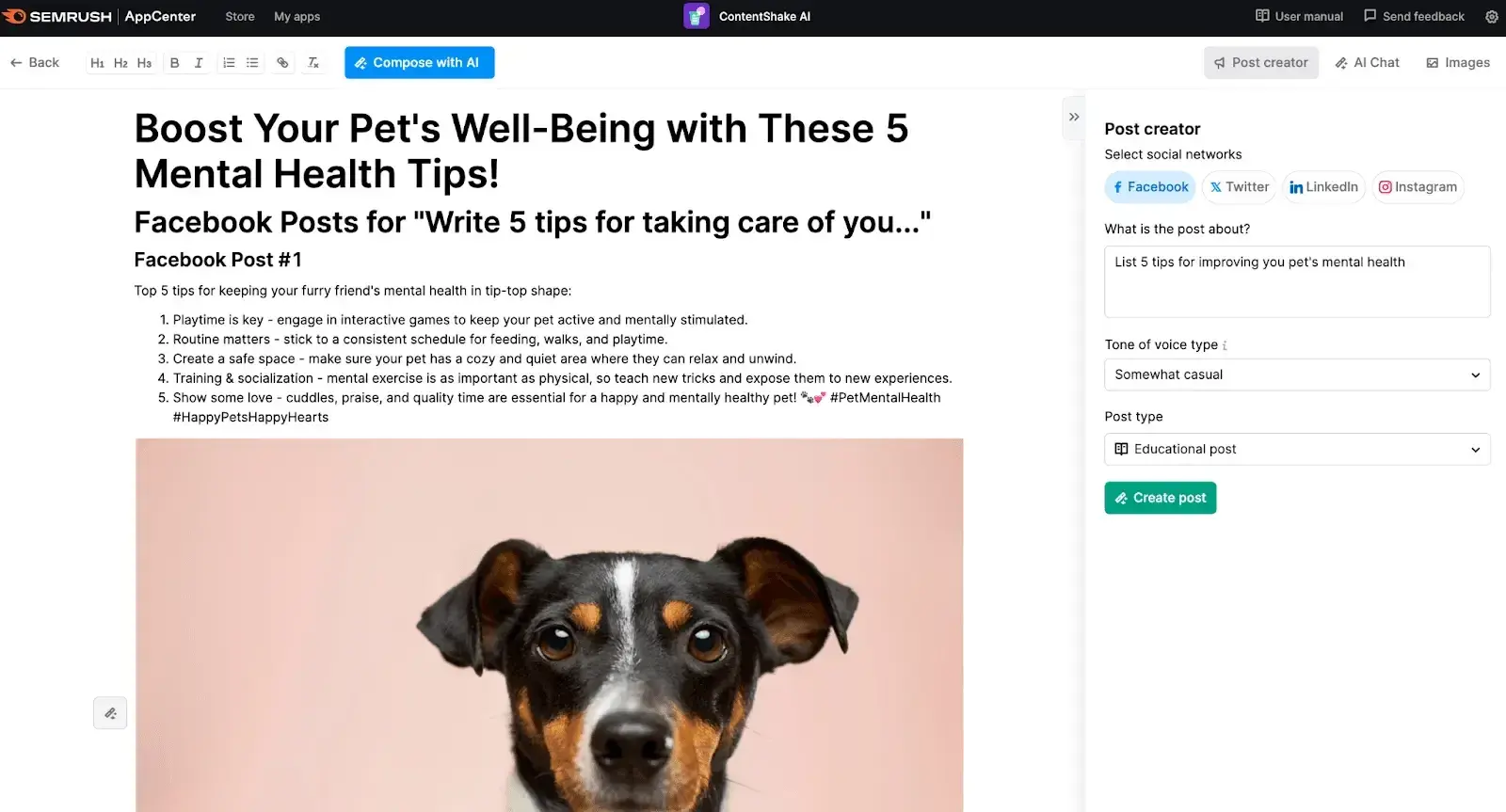
- Scheduling and Posting: AI-powered social media scheduling tools can help you automatically post your content at the most effective times and even optimize your content for specific social media platforms.
- Audience Analytics: AI can help you better understand your audience through data analysis. This information can then be used to craft more effective and relevant social media posts.
3. Long-Form Content — Blogs, Articles, etc. (46{326198e71d5f7582f354f6f6ee7a089ba2f57e2fa39b69186a2948f78a2d5740})
46{326198e71d5f7582f354f6f6ee7a089ba2f57e2fa39b69186a2948f78a2d5740} of marketing professionals found artificial intelligence tools helpful for writing blog posts. As a writer myself, one of the first thoughts I had when introduced to AI was how it could improve my writing process.
Some of the best uses for AI writing generators in blog posts are:
- Efficiency: Marketers can save time and resources by automating various aspects of blog post creation, such as topic generation, research, and even drafting. In fact, 41{326198e71d5f7582f354f6f6ee7a089ba2f57e2fa39b69186a2948f78a2d5740} of survey respondents use AI to create blog post outlines. This technology can also reduce the time spent on menial tasks like formatting, proofreading, and optimizing content for A1 SEO.
- Personalization: AI can analyze customer behavior, preferences, and browsing history to help target blog content to specific audiences. Personalizing blog posts can make the content more relevant to the audience, potentially increasing engagement and conversion rates.
For those looking to improve their blog content creation, look no further than HubSpot’s content assistant. This platform feature is a suite of free, AI-powered features that help you ideate, create, and share remarkable content—in a flash.
Furthermore, to make your content creation process even better, HubSpot also has a free Blog Ideas Generator to help you generate engaging content ideas.
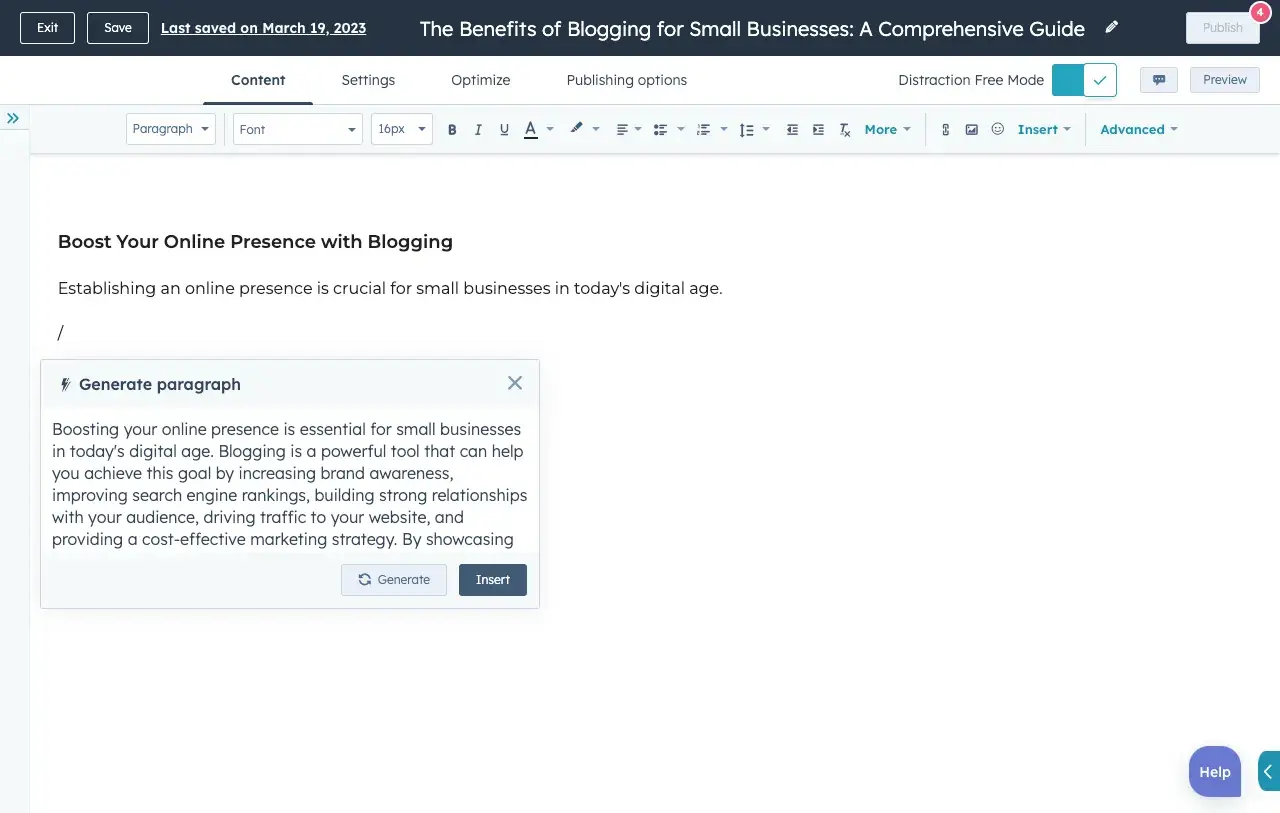
Get started with HubSpot’s AI tools
Did you know you can even build a blog post in 10 minutes or less with the help of AI? Here’s how.
AI-Generated Marketing Content in 2024
In 2024, AI‘s advancements and its growing presence in marketing is shaking up the marketing industry.
Yet, it’s crucial to navigate the ethical and regulatory challenges to ensure this transformation benefits everyone — businesses and consumers alike.
First off, the market for AI in marketing is booming. A Precedence Research report shows that the global AI market is expected to hit $2.6 billion by 2032, with an annual growth rate of 19{326198e71d5f7582f354f6f6ee7a089ba2f57e2fa39b69186a2948f78a2d5740}.
This surge is largely thanks to the rising use of generative AI tools, which are now key to creating personalized and scalable content.
On the tech front, AI models like GPT-4 have made leaps in understanding and producing human-like text. This means businesses can now automate content creation across social media, blogs, and email marketing without losing quality.
McKinsey notes that companies aren’t just cutting costs but also seeing significant revenue growth from using AI in marketing and sales.
Recent headlines showcase AI’s practical wins in marketing.
For instance, HubSpot’s 2024 State of Marketing report reveals that marketers are saving 3 hours per content piece and 2.5 hours per day overall.
Moreover, Coca-Cola’s AI-generated personalized ads have notably increased reach and consumer engagement, proving the real-world benefits of AI-driven marketing.
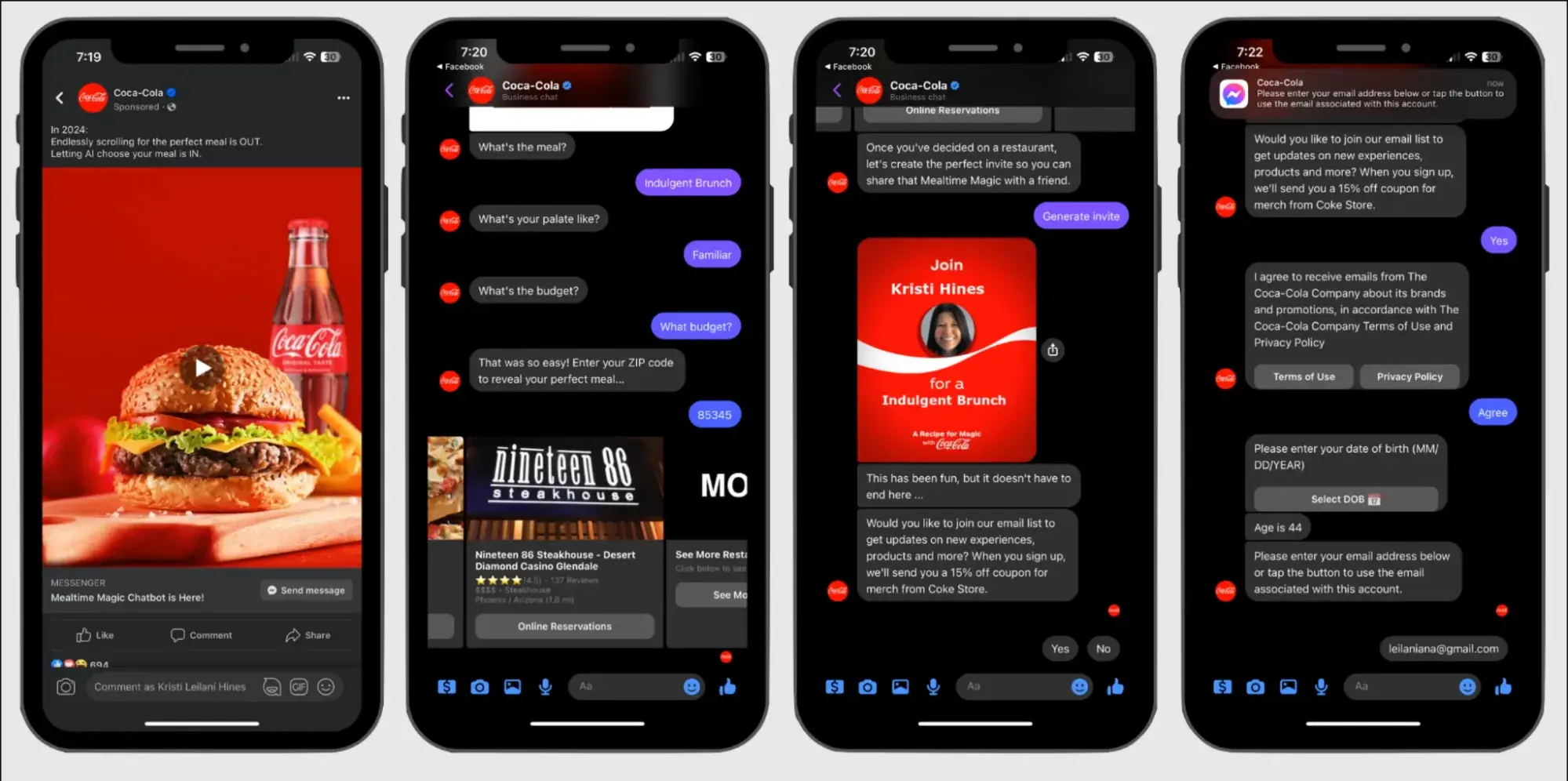
But it’s not all smooth sailing.
This rapid adoption of AI brings challenges, especially around data privacy, intellectual property, and the accuracy of AI-generated content.
Our survey found that while half use AI for specific tasks, 46{326198e71d5f7582f354f6f6ee7a089ba2f57e2fa39b69186a2948f78a2d5740} feel overwhelmed by integrating AI into their workflow.
Six in ten AI-using marketers are wary of biases, plagiarism, or misalignment with brand values. This cautious stance highlights the need to balance AI’s advantages with maintaining brand integrity.
The regulatory landscape is also shifting to keep up with AI. The European Union’s proposed AI Act aims to regulate high-risk AI applications, including those in marketing, to ensure ethical practices and protect consumers.
This regulatory push is vital for maintaining trust and preventing AI misuse.
Personally, I find the future of AI-generated marketing content both exciting and complex. AI offers unmatched efficiency and personalization, but it also demands a careful balance of innovation and ethics.
As businesses adopt AI, focusing on transparency, quality control, and human oversight is crucial to harness its potential while avoiding pitfalls.
AI-Generated Content Marketing Pros and Cons
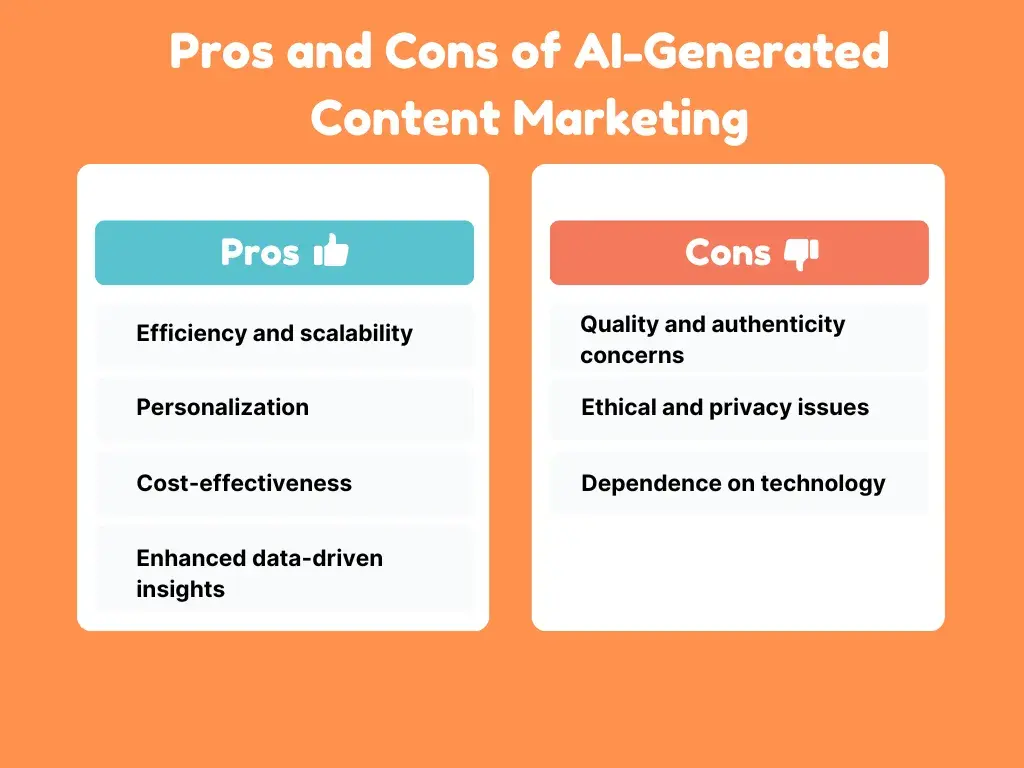
Pro: Efficiency and Scalability
AI-generated content marketing supercharges efficiency and scalability.
With AI tools, you can churn out a huge volume of content in a fraction of the time it would take a human. This is gold for businesses needing a consistent online presence across multiple platforms.
I’ve seen firsthand how AI can generate personalized email campaigns, social media posts, and blog articles quickly and efficiently.
This efficiency frees up my marketing team to focus on strategy and creativity instead of getting bogged down by the grind of content creation.
Automating routine tasks lets us scale our content efforts without expanding our team, which is a massive cost-saving measure.
Con: Quality and Authenticity Concerns
AI-generated content often gets a side-eye for its quality and authenticity.
Even the most advanced AI models can produce content that misses the mark on nuanced understanding and emotional depth, making it feel generic or disconnected.
86{326198e71d5f7582f354f6f6ee7a089ba2f57e2fa39b69186a2948f78a2d5740} of marketers who use AI to create written content make edits to the content that AI produces, according to the 2024 State of AI in Marketing.
Likewise, I make a point to carefully review and edit whenever my team and I use AI-generated content.
Pro: Personalization
From my perspective, delivering personalized content is the true game-changer in marketing. It allows brands to provide a more relevant and engaging customer experience, which in turn boosts loyalty and sales.
In fact, 72{326198e71d5f7582f354f6f6ee7a089ba2f57e2fa39b69186a2948f78a2d5740} of marketers who use AI and automation report that it significantly enhances their ability to personalize customer experiences.
Furthermore, 7 in 10 marketers using these technologies believe that AI improves the overall customer experience.
For example, AI can analyze a user’s browsing history, past purchases, and interaction patterns to recommend products or craft personalized marketing messages.
This level of insight allows brands to connect with customers on a more intimate level, delivering content that feels tailored and relevant.
Con: Ethical and Privacy Issues
However, AI in content marketing also stirs up ethical and privacy concerns.
AI systems need loads of data to work well, which can lead to data privacy and security issues. There’s also the risk of misusing AI-generated content, like creating deepfakes or spreading misinformation.
We must navigate these challenges by implementing robust data protection measures and adhering to ethical guidelines.
Regulations like the European Union’s proposed AI Act and California’s Consumer Privacy Act (CCPA) impose strict data privacy rules.
This ensures consumers have more control over their personal information, thereby impacting how we use AI in marketing.
Pro: Cost-Effectiveness
The cost-effectiveness of AI in content marketing is a major advantage for marketing teams.
Automating content creation reduces the need for a large team of writers and editors, significantly cutting labor costs.
In fact, 34{326198e71d5f7582f354f6f6ee7a089ba2f57e2fa39b69186a2948f78a2d5740} of marketers agree on this point. With these savings, resources can be reallocated more efficiently, allowing investment in other critical areas like product development and customer service.
Moreover, AI tools help optimize marketing campaigns, leading to a better return on investment. Nearly 68{326198e71d5f7582f354f6f6ee7a089ba2f57e2fa39b69186a2948f78a2d5740} of leaders who invested in AI have reported a positive ROI on their investment.
This is particularly beneficial for startups and SMEs looking to maximize their marketing budget.
Con: Greater Dependence on Technology
Over-reliance on AI for content creation can lead to a dependence on technology.
This might stifle critical thinking and creativity in your marketing strategies. If AI systems glitch or produce subpar content, it can disrupt our marketing efforts.
My hot take? While AI is a powerful tool, it should complement—not replace—human creativity and judgment.
We need a balanced approach, leveraging AI for efficiency while ensuring human oversight and creative input remain integral to the content creation process.
Pro: Enhanced Data-Driven Insights
AI-generated content marketing offers superior data-driven insights.
AI tools analyze vast amounts of data to identify trends and behaviors that might not be immediately obvious. These insights inform more effective marketing strategies and allow for precise audience targeting.
I’ve seen how using AI for data analysis provides us with a comprehensive understanding of customer behavior, enabling the creation of highly relevant content that resonates with audiences.
AI can analyze social media interactions and website analytics to predict content performance and tailor our marketing efforts accordingly.
Moreover, AI tools can monitor and analyze our marketing campaigns in real time, allowing for rapid adjustments and optimization based on the latest data insights.
This ensures our marketing strategies stay effective and relevant.
AI-Generated Content Marketing Tips
Treat AI as a collaborator.
As I mentioned before, AI isn’t here to replace human creativity — it’s here to enhance it.
Using AI for tasks like keyword research, trend analysis, and content distribution strategies frees up your time for creative work that sets your brand apart.
This collaboration boosts efficiency while maintaining your brand’s unique human touch. For instance, I use AI tools like GPT-4 for initial content drafts and data analysis.
Like this:
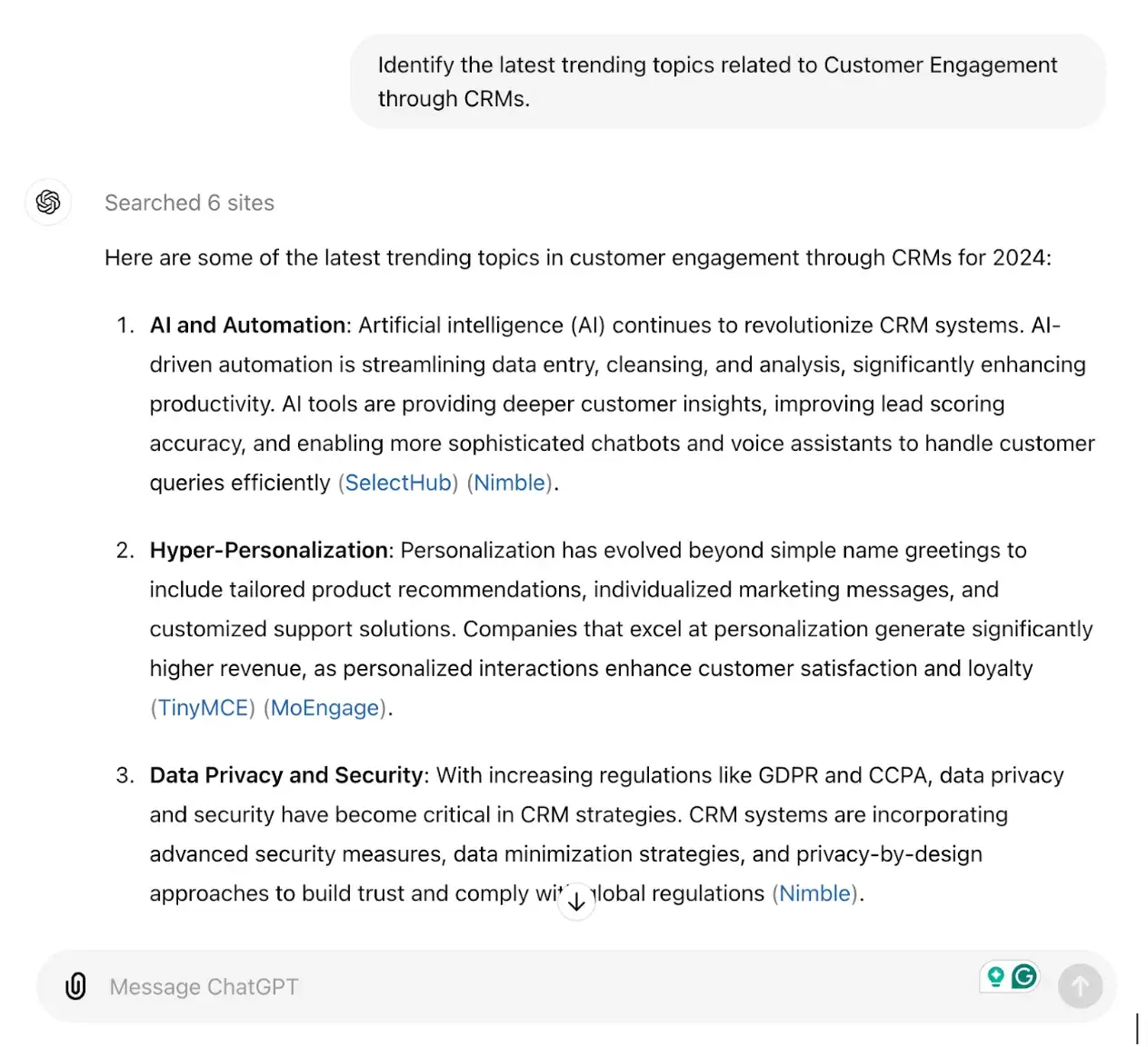
AI quickly generates trending topics and keywords, which I then tailor to our brand’s voice and add my personal touch. This balances efficiency and creativity, keeping my content authentic and engaging.
Create unique, non-replicable content.
AI-generated drafts are just a starting point. Your final content should reflect our brand’s unique voice and insights, ensuring it stands out and offers real value.
In practice, I use AI to create outlines and drafts, but I always personalize them with my own experiences and viewpoints.
For example, if AI provides an overview of a topic, I enhance it with my analysis, case studies, or SME interviews. This approach differentiates my client’s content and builds trust with our audience.
Automate SEO management and content distribution.
For SEO management, I use tools like Clearscope and SurferSEO to quickly identify high-potential keywords and optimize content. These tools provide real-time performance insights, showing me what works and what doesn’t.
Then, by continuously monitoring and adjusting our strategy, my client maintains a strong online presence without getting bogged down in SEO minutiae.
Plus, AI’s ability to adapt to changing algorithms ensures our approach stays effective and up-to-date.
On the distribution side, I rely on AI tools to ensure my content reaches the right audience at the right time for maximum impact.
For instance, CoSchedule schedules posts, distributes content across platforms, and optimizes timing based on audience activity.
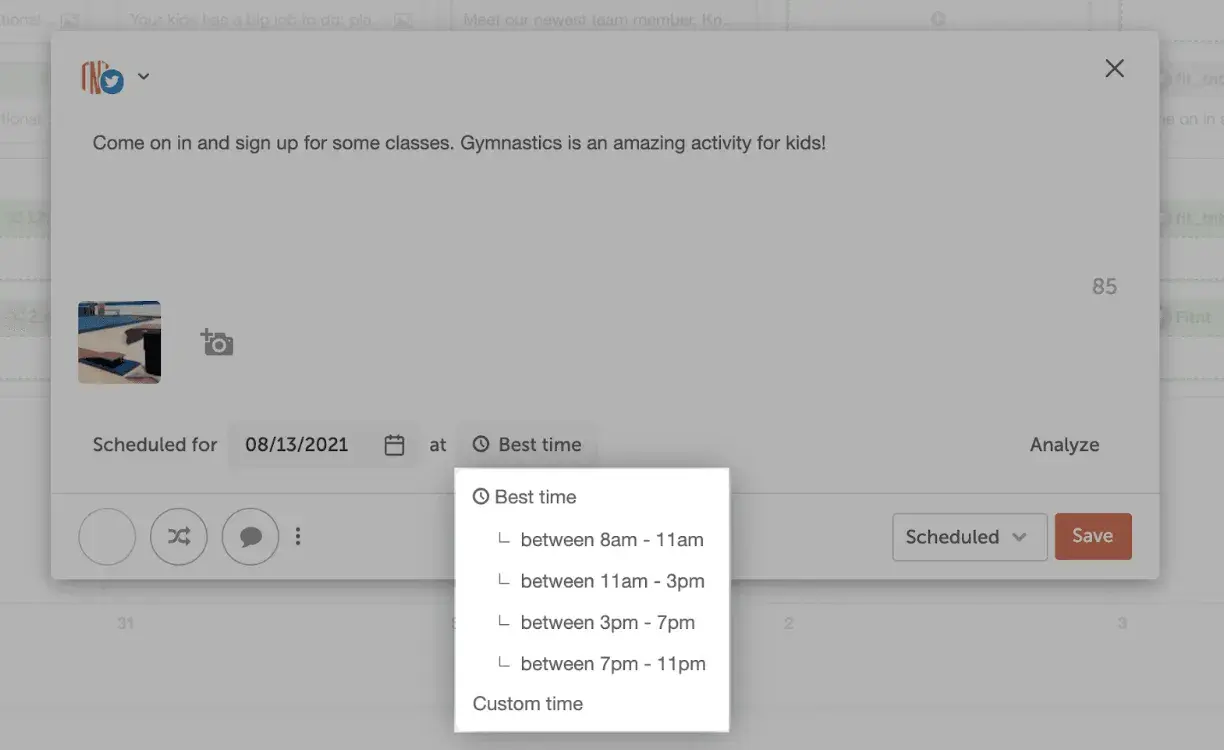
This way, I maintain a consistent posting schedule without the manual hassle, boosting my client’s engagement and reach.
Use creative AI prompts.
When I’m stuck, using AI prompts often jumpstarts my creative process.
AI might suggest a unique angle on a trending topic or generate a list of related subjects I hadn’t considered.
Think of these AI-generated prompts as a starting point to spark new ideas and overcome writer’s block. While AI can’t replicate human creativity, it can provide the inspiration we need.
Prompts are a two-way street, so you must input effective prompts to get high-quality outputs. Try these:
- Trending topics: “Analyze how remote work has transformed team collaboration in the tech industry, focusing on both positive and negative aspects. Include real-world examples of tech companies that have successfully implemented remote work policies, as well as challenges they faced.”
- Unique angles: “Investigate the connection between sustainable business practices and brand loyalty among Gen Z consumers. Examine the specific values and expectations of Gen Z regarding sustainability, and how brands can authentically meet these demands.”
- Related subjects: “Examine how AI is transforming customer service through improved efficiency and customer satisfaction. Discuss various AI applications such as chatbots, virtual assistants, and predictive analytics. Highlight the key advantages.”
Use AI for Dynamic Content Optimization
Dynamic content optimization involves constantly tweaking your content based on real-time data.
I’ve found HubSpot’s AI tools incredibly useful for this—the tool provides insights into how different audience segments interact with our content.
For example, HubSpot‘s analytics revealed that our readers prefer blog posts with case studies and real-life examples. So, I started adding more of these elements, and engagement shot up.
HubSpot’s AI also helps with A/B testing content variations, refining my client’s strategy for the best performance.
Editor’s note: This post was originally published in May 2023 and has been updated for comprehensiveness.


